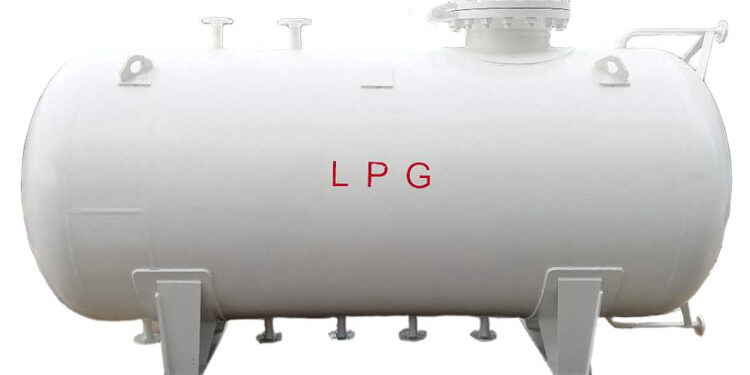- Introduction:
Liquefied Petroleum Gas (LPG) storage tanks are essential for storing LPG in a pressurized liquid form. The materials used in constructing these tanks and tank wall thickness are critical for maintaining the tank’s integrity under high pressure and fluctuating temperatures while ensuring safety and preventing corrosion.
- Types of LPG Storage Tanks
LPG storage tanks are typically categorized by their structure and intended use. The main types include:
- Above-Ground Storage Tanks (AGST): These are the most common LPG storage tanks, often cylindrical or spherical in shape, and can range in size from small household tanks to large industrial units.
- Underground Storage Tanks (UGST): Installed below ground, these tanks are suitable for areas where space is limited or where the aesthetic impact of above-ground tanks needs to be minimized.
- Horizontal and Vertical Cylindrical Tanks: These shapes are commonly used for industrial and commercial LPG storage and allow flexibility in installation based on site conditions.
- Design and Construction
LPG storage tanks are designed with safety as a primary consideration. Key elements in their construction include:
- Material: Typically, LPG tanks are mostly made from steel, which provides strength and durability. Special coatings are often applied to protect against corrosion.
- Pressure Ratings: LPG storage tanks are built to withstand high pressures, typically between 100-250 psi (pounds per square inch) or 6 – 17 bars of pressure to keep LPG in liquid form. Pressure relief valves are installed to release gas if pressure exceeds safe levels.
- Temperature Control: Since LPG vaporizes at relatively low temperatures, tanks are designed to maintain stability by preventing excessive heat or cooling. Some installations use insulation or external cooling systems to control the temperature.
- Welded Construction: Tanks are usually fabricated through welded joints for structural integrity.
Material Selection Criteria
- Pressure Resistance: Materials need to withstand the internal pressure required to store LPG in liquid form.
- Corrosion Resistance: Corrosion-resistant materials or coatings are essential to prevent deterioration, especially in outdoor or underground installations.
- Temperature Tolerance: Materials must endure temperature variations without becoming brittle or structurally compromised.
- Cost: Cost-effectiveness is a significant consideration, especially for large-scale storage tanks. Steel with protective coatings offers a balance between cost and durability.
- Factors Affecting LPG Storage Tank Wall Thickness
Several factors influence the required wall thickness of an LPG storage tank:
- a) Operating Pressure and Temperature.
Pressure: Higher pressure requires thicker tank walls to prevent deformation and potential rupture. Most LPG tanks operate between 100 to 250 psi, but precise pressure requirements are based on specific use cases.
Temperature: Temperature changes impact the behavior of the tank material. In cold environments, materials can become brittle, necessitating a thicker wall to maintain strength. Conversely, high temperatures can increase internal pressure, requiring a thicker wall to handle the stress.
- b) Tank Size and Capacity
Larger tanks generally require thicker walls due to the larger surface area subjected to internal pressure. As tank size and LPG capacity increase, the material must compensate for the added structural demands to maintain safety.
- c) Material Properties
Strength and Ductility: Materials with higher tensile strength, such as carbon steel or stainless steel, may allow for thinner walls compared to materials with lower strength. Corrosion Resistance: Materials that are more prone to corrosion require a greater thickness to allow for potential thinning over time.
- d) Environmental Factors
In corrosive or moisture-rich environments, thicker walls are essential to protect against the gradual thinning caused by rust or chemical reactions. Underground tanks, for example, face increased corrosion risks and may be built with thicker walls or additional corrosion-resistant coatings.
Calculating Appropriate Wall Thickness
The required wall thickness for LPG storage tanks is calculated based on formulas provided in industry standards like ASME BPVC. These formulas consider several parameters such as Internal design pressure, allowable stress for material and joint effeciency
- Safety Features of LPG tank
LPG storage tanks are equipped with various safety features to mitigate risks:
- Pressure Relief Valves: These valves release gas if internal pressure exceeds a preset level, preventing tank rupture.
- Excess Flow Valves: These valves stop the flow of LPG if there is a sudden release, such as in the case of a pipe rupture.
- Emergency Shut-Off Valves: These are manually operated or automatic valves that close to stop LPG flow in an emergency.
- Automatic Tank Gauging Systems: Modern tanks include systems that monitor pressure, temperature, and liquid levels, alerting operators to potential issues.
- Ventilation and Fire Protection Systems: Proper ventilation and fire suppression systems are essential, especially in industrial storage sites, to handle any leaks or accidental releases of gas.
- Installation and Maintenance
The installation of LPG storage tanks is regulated by safety standards and often overseen by local authorities. Some considerations for installation include:
- Distance from Buildings and Boundaries: Tanks must be installed at a safe distance from residential or occupied areas. Clearances are determined based on the tank’s capacity.
- Foundation: A stable and fire-resistant foundation is necessary for the safe placement of both above-ground and underground tanks.
- Regular Inspections: Tanks are subject to regular inspections to ensure they are free from corrosion, structural damage, or valve failures.
- Leak Detection: LPG tanks are fitted with leak detection systems, and personnel must be trained to respond quickly to leaks.
- Conclusion
LPG storage tanks are essential components of LPG storage and distribution, providing a safe and efficient means to store liquefied gas for various applications. The materials used in constructing LPG storage tanks are selected based on their ability to withstand high pressure, resist corrosion, and ensure long-term safety. The thickness of LPG storage tank walls is a critical parameter that impacts the tank’s safety, durability, and cost-effectiveness





